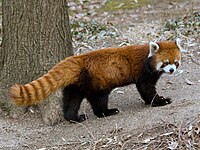
Photo from wikipedia
This study aimed to evaluate the cryopreservation effects on the semen of oncilla (Leopardus guttulus, n = 5, 15 ejaculates) and ocelot (Leopardus pardalis, n = 5, 17 ejaculates) and compare two extenders (commercial… Click to show full abstract
This study aimed to evaluate the cryopreservation effects on the semen of oncilla (Leopardus guttulus, n = 5, 15 ejaculates) and ocelot (Leopardus pardalis, n = 5, 17 ejaculates) and compare two extenders (commercial and non-commercial extender). An andrological exam was conducted (testicle measurements and penis evaluation), including semen collection by electroejaculation. After collection, the semen was assessed to volume, color, pH, sperm motility, vigor, sperm number in the ejaculate, viability, membrane integrity, and sperm morphology. Samples were centrifuged (300 g for 10 min) and pellet diluted in two extenders (TRIS/glucose/egg yolk and BotuCRIO®), packed into 0.25 mL French straws (20 × 106 spermatozoa/mL), equilibrated at 5 °C for 1 h (<0.5 °C/min), freezing in nitrogen vapor for 20 min. Thawing was achieved at 46 °C for 15 min. Thawed samples were evaluated to the same characteristics and ultrastructural analysis. There is no difference for extenders, but in ocelot the spermatozoa maintained higher quality after thawing. Major defects were increased in thawed samples, especially acrosome injuries, in both species. Semen contamination by urine was remarkable to oncilla (53% of the ejaculates) which can have reduced sperm cryoresistance of this species. Ultrastructural analysis endorsed morphological analysis under light microscopy and identified cells with acrosome vesiculation. In conclusion, the spermatozoa of ocelot were more cryoresistent and the extender commercial and non-commercial were suitable for their cryopreservation. Other extenders should be investigated for oncilla.
Journal Title: Theriogenology
Year Published: 2021
Link to full text (if available)
Share on Social Media: Sign Up to like & get
recommendations!